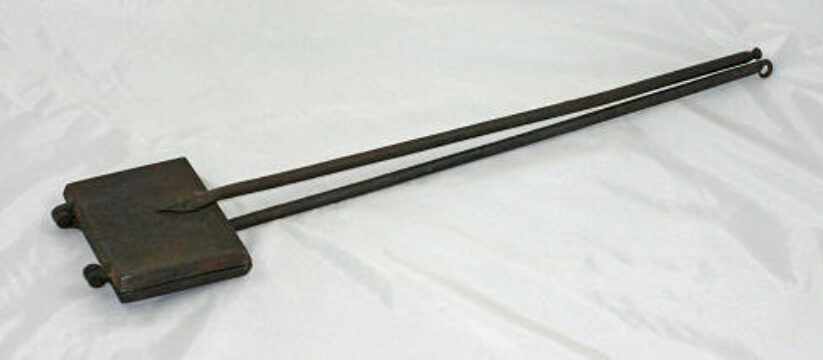
The Rosenberg Library Museum featured a 19th century waffle iron, originally belonging to Samuel May Williams, as the September Treasure of the Month. Donated by the estate of Thomas Jefferson League in 1923, this waffle iron design was first patented in 1869.
Waffles are griddle-cakes made of flour, milk, eggs, and butter that are pressed between iron molds to form crispy, caramelized delights. Often used for breakfast foods and as sweet treats, waffles have been used like toast or as wraps around savory meat dishes for centuries. Traditional waffle irons, manufactured from the 14th century through the early 20th century, were made of two cast iron plates that were heated atop a stove.
First eaten by the Greeks as obleios, or flat cakes, waffles and waffle irons became cultural staples in the Low Countries of Northern Europe in the 1300s. These waffle irons were constructed of hinged plates connected by long wooden handles and embossed with elaborate patterns of landscapes, coats of arms, religious symbols, or the honeycomb-grid pattern we know today. Dutch pilgrims brought waffle irons to America in the 1620s. In the late 1700s, Thomas Jefferson brought a waffle iron back as a souvenir from his travels in France. Waffle frolics were then organized by the well-to-do where party guests enjoyed waffles topped with fruits, maple syrup, or meat and kidney stew. In 1881, Mrs. Abby Fisher published What Mrs. Fisher Knows about Old Southern Cooking. This cookbook, the first cookbook written by an African American, included recipes for waffles and fried chicken, a food combination still enjoyed by all true Southerners today.
The first patented waffle iron was designed by Cornelius Swarthout in 1869. His design included a swivel hinge in a cast iron collar that joined two embossed iron plates. In 1911, General Electric rolled the first fully electric waffle irons off the assembly line, complete with built-in thermostats to prevent overheating. The double waffle iron was then on the market in 1926 and was the basis for most waffle irons today, including 1939’s iconic “Twin-O-Matic” waffle iron. Frozen waffles, including Eggo’s “Leggo My Eggo” waffles, were available in grocery stores by 1953. The Belgian waffle, a thicker and fluffier waffle than the traditional American waffle, was brought to the states in 1964 at the New York World’s Fair.

Waffles were highly regarded in Texas because they could easily be prepared without the use of stoves – a blessing during hot summer months. Waffle irons were used to make waffles for breakfast, cornbread for lunch, and ginger bread for after-dinner dessert. Recipes and waffle iron tips frequently ran in The Galveston Daily News section “Suggestions for Thrifty Housewives” in the 1930s, and ads from Galveston department stores suggested “fancy electric gifts,” like waffle irons for Christmas in the 1920s – 1950s. Waffle irons were frequent prizes in area competitions through the 1930s, and the Galveston Electric Company sold waffle irons, along with waffle serving sets, for $12.50.
The waffle’s most interesting claim to fame had nothing to do with food — but with shoes. In 1971, Oregon track coach and Nike co-founder Bill Bowerman poured liquid urethane into his wife’s waffle iron. Impressed with this lightweight and gripping material, Bowerman used the honey-combed urethane as the sole of Nike’s 1972 “Moon Shoe.” Nike introduced its now iconic “Waffle Trainer” in 1974, a refined version of the Moon Shoe, making the Nike shoe company a household name.
Today, waffle irons come in a variety of shapes, from Texas to Mickey Mouse, and from hearts to dinosaurs. Waffles are sold by street vendors and in cafés across the world. Waffles even have a handful of holidays such as International Waffle Day (March 25), National Waffle Day (August 24), and National Waffle Week (first week in September).